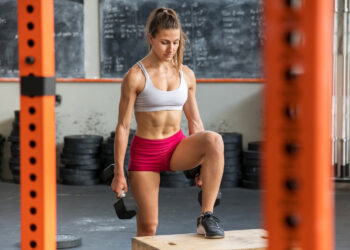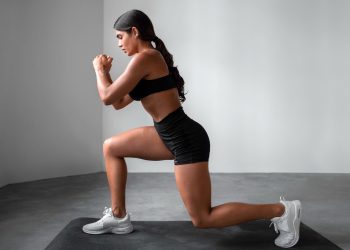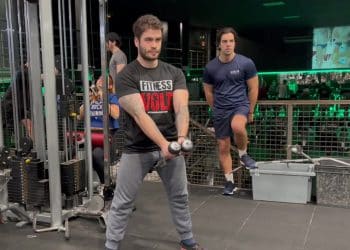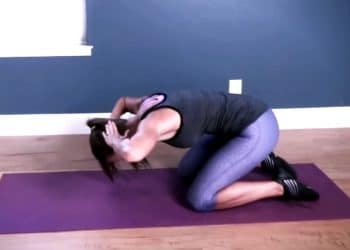How many times a day do you bend over?
You probably have to bend to pick up your clothes and shoes in the morning, or pick up your kids’ toys from the floor. You bend a lot when you’re cleaning your garage, putting the shopping away, or tidying up your house. More than likely, you do plenty of bending at the gym to pick up weights from the floor or perform exercises that target your lower body.
Every time you bend, your hips act like a hinge to fold your upper body forward over your lower body. The hip hinge is one of the most crucial and necessary movements, which is what makes the hip and pelvic muscles so important for a healthy, full range of motion.
If your hip mobility is lacking, you’ll find that you tend to feel stiff or rigid when you try to bend. Your hips and pelvic muscles might not have the power to move smoothly (especially when you add weight into the mix), your lower back has to provide additional support. Unfortunately, this increases the risk of lower back strain.
A healthy, strong, and properly mobile hip hinge will help you keep your spine neutral through the entire motion, moving the way your body was intended to and using only the hip flexors and extensors to do the work.
If you’ve noticed limitations in your hip hinge (stiffness when you bend, or pain in your lower back as you straighten), you may be wondering how to improve your strength and mobility. Lucky for you, we’ve collected a few hip hinge exercises you can do to solve the problem!
Level Up Your Fitness: Join our 💪 strong community in Fitness Volt Newsletter. Get daily inspiration, expert-backed workouts, nutrition tips, the latest in strength sports, and the support you need to reach your goals. Subscribe for free!
Before You Start Training…
It’s a good idea to test your hip hinge motion before you start training. You need to know whether you’re moving correctly or not before you add weight and do exercises that could cause lower back strain due to improper form.
To start, stand with your back against the wall. Make sure your heels are touching the wall, as well as your butt. Now, bend forward from the waist, keeping your butt, the backs of your legs, and heels planted firmly against the wall. This is what a hip hinge feels like when your lower body is stationary and only your upper body moves.
Now, time to test your upper body. Grab a long wooden stick, a metal bar, or even a broom handle—literally anything straight and longer than 3 feet (1 meter). Hold one end to the back of your head or neck, and the other end at or below butt level. Straighten your back until you feel the stick along the length of your spine—correct spinal alignment. Bend forward at the waist, and see if you can maintain that contact between the stick and your back.
For those with weak or inflexible hip hinges, the lower back will often round to accommodate the insufficiency, and the stick will break contact with your upper back. The motion will occur at the lower back joints as well as the hip joint—a sign that it’s not quite right!
After these tests, you’ll have a pretty good idea of what you’re working with, what your range of motion and posture is. Time to dive into the hip hinge exercises below!
Good Mornings
This is an amazing exercise that is typically used to target your lower back strength, but can be adapted to focus more on the hip hinge. Reducing the amount of weight used and paying close attention to the movement of your hips and pelvis will help you target the critical muscles engaged in the movement and improve your mobility.
To perform this exercise:
- Stand with your feet in a neutral/comfortable stance, with a neutral spine and head straight.
- Hold a weight behind your neck (barbell, kettlebell, or dumbbell), or, if you so choose, perform this with just your bodyweight to focus on the range of motion.
- Bend your knees slightly but keep your lower back straight as you hinge forward at the hips, with your weight primarily on your heels. Lower your upper body until you’re close to 90-degree angle.
- Using only the muscles in your hips and pelvis, push your upper body back into the starting upright position.
- Repeat as desired.
This exercise works your hamstrings, glutes, and hip hinge, and lower back. If you keep your upper body perfectly straight and your spine neutral, you’ll shift the focus from your lower back downwards to improve hip hinge and lower body power.
Related: Good Morning Exercise Guide.
Kettlebell Bent Over Row
The row is a classic Upper Back exercise that also targets your shoulders and arms, but performing it in a bent over position will also give your hip hinge a solid workout. You’ll have to pay special attention to your lower back to avoid engaging those spinal muscles, so start with light weight and focus on keeping your back isolated and maintaining a static bent-over position using your hip hinge muscles.
To perform this exercise:
- Stand with your feet in a neutral/comfortable stance.
- Hold a kettlebell in one or both hands (unilateral or bilateral exercise).
- Hinge forward at the hips until you’re at close to a 90-degree angle, your upper body parallel to the floor. Keep your weight on your heels, bend your knees a little, and push your hips backward to ensure your hamstrings, glutes, and hip hinge muscles are doing most of the work, not your lower back.
- Row the weights up to your chest. You’ll have to engage your core to remain stable in this position, but resist the urge to let your lower back round. Keep your entire upper body aligned in a neutral spine position to focus the exercise on your hip hinge and lower body, not your lower back.
- Resist the urge to let your shoulder muscles drop or hunch up toward your ears as you row.
- Perform a set of 10-15 reps, then carefully set the weights down and stand back up to your starting position, using your hip hinge muscles to straighten rather than your lower back.
Maintaining the bent-over position will help you work on supporting the load using your hip hinge muscles, and you’ll learn to bend and straighten more smoothly.
Level Up Your Fitness: Join our 💪 strong community in Fitness Volt Newsletter. Get daily inspiration, expert-backed workouts, nutrition tips, the latest in strength sports, and the support you need to reach your goals. Subscribe for free!
Related: The One Kettlebell Workout.
Hip Thrusters
Hip Thrusters are absolutely amazing for developing hip hinge strength, increasing your range of motion, and strengthening the lower back, glute, and hamstring muscles that work with the hip hinge muscles. Whether you do them weighted or just using your bodyweight, they’re an excellent addition to your hip hinge workout.
To perform this exercise:
- Lay on your back on an elevated surface (bench or block) with your knees bent and feet planted flat on the floor.
- Use your glutes and core muscles to lift your torso, forming a straight line along your shoulders, upper body, hips, and legs all the way to the knees. Drive your heels down into the floor, and flex your glutes to push your hips as high into the air as you can.
- Return to your starting position (relaxed), and repeat as desired.
This exercise is incredibly simple (and safe when performed with just your bodyweight), but it’s hyper-effective at developing better hip hinge mobility and strength.
You’ll find that the act of pushing upward to form a “bridge” with your body improves your range of motion and develops the muscles that are involved in bending forward and straightening.
Kettlebell Swing
The Kettlebell Swing is a very dynamic exercise with a lot of moving parts, which makes it very easy to perform incorrectly (shifting the focus to your lower back rather than your hips). It’s worth putting in effort to master the form using very light weight at first, and only working heavier once you are in control of your full range of motion.
To perform this exercise:
- Stand with your legs spread beyond shoulder width apart and your back and neck straight.
- Grip a kettlebell in both hands, letting it hang down in front of your groin.
- To begin, lower your body into a half-squat, hinging forward at the hips to bring the kettlebell back toward your butt.
- Swing the kettlebell forward using ONLY your hip hinge and arm muscles—tighten your core and keep your spine straight to avoid using your lower back.
- Keep the kettlebell swinging all the way up until it is either at chest height or, if you’re going for a more shoulders-oriented workout, above your head.
- As the weight comes down, hinge forward at the hips (still keeping your spine straight and core tight) and let the kettlebell swing down toward your butt again.
- Repeat as desired.
Mastering the form of this dynamic, full-body exercise isn’t easy. You’ll be tempted to let your lower back do more work, and you’ll feel it begin to round forward and your abs relax. Resist that urge!
Use your abs, glutes, hamstrings, and hip hinge muscles to bear the weight as you bend forward and straighten. The less work your lower back does, the more your hip hinge muscles are strengthened.
Related: Kettlebell Swing Exercise Guide.
Kettlebell Single Legged Romanian Deadlift
This is a much more advanced exercise, but one that will lead to serious improvements for your hip hinge. The complexity and balance required place the focus directly on your hip and pelvic muscles, forcing them to do most of the work as you deadlift the weight.
To perform the exercise:
- Stand with your weight balanced entirely on your right leg, using your left leg to add support and balance as needed.
- Hold a kettlebell in your left hand, and extend your right arm out to the side for balance.
- Slowly hinge forward at the hips and lower the weight to gently tap the floor. Bend your right knee slightly to maintain your balance and keep the focus on your glutes and hamstrings.
- Use your hip hinge muscles, glutes, hamstrings to stand back up, lifting the kettlebell with you.
- Repeat as desired, then switch hands and feet (weight in right hand, balancing on your left foot).
This exercise will demand a lot of coordination, stability, and hip hinge strength. You may not have it at first, but don’t let that stop you from including this in your training sessions. This is one of the absolute best exercises to develop serious hip hinge mobility and power.
Kneeling 1-Side Loaded Hip Extension
If you’ve got a cable machine handy, this is an amazing exercise to develop hip hinge strength using a unilateral load. The imbalance will actually improve your stability, because it forces your body to adapt to an uneven load and recruits more secondary muscles along with your hips.
To perform this exercise:
- Kneel on a folded up mattress or pad, with your back to the cable machine.
- Use a D-handle to grip the cable securely in front of your waist (aim for the spot directly beneath your belly button), with the cable running alongside your left hip.
- Hinge backward to bring your butt close to your heels, then press your hips forward against the resistance of the cable to return to your original position.
- Repeat as desired, then switch sides (left hip, then right hip).
This exercise will feel awkward, and it’s supposed to! The one-sided load will force your core and lower body muscles to engage as well, stabilizing and strengthening your entire midsection.
Conclusion
Training your hip hinge to be stronger and more mobile will improve your posture, facilitate easier movement, reduce injury risk, and even increase flexibility. The best way to improve is with the hip hinge exercises listed above–include them into your daily workout routines, and you are guaranteed to see marked improvement in every aspect of your fitness!








